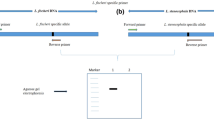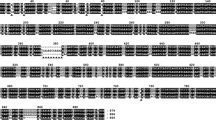Abstract
Schizonepeta tenuifolia (Korean name “Hyung-Gae”) is an oriental medicinal plant that is widely used in Korea, China and Japan. S. tenuifolia (Hyung-Gae) has many pharmacological activities and is mostly used for many medicinal preparations. The dried aerial part (spikes and stems) of three oriental medicinal plants, S. tenuifolia (Hyung-Gae), Agastache rugosa (Kwhak-Hyang) and Elsholtzia ciliata (Hyang-Yoo) belonging to the same family, mint family Labiaceae, have such similar shape and smell that it is difficult to differentiate between them. The trnL-F regions of chloroplast DNA of the three medicinal plants were sequenced and used as targets in multiplex PCR reaction to identify S. tenuifolia. After alignment of trnL-F sequences of the authenticated plant samples, one single nucleotide polymorphism (SNP) specific to S. tenuifolia was found. Based on this SNP, a new primer was designed that specifically amplifies the trnL-F region of S. tenuifolia. The established multiplex-PCR was proven to be effective in the differentiation of commercial S. tenuifolia samples from A. rugosa and E. ciliata. This rapid and accurate molecular method is highly promising for use in the food industry.



Similar content being viewed by others
References
Aagesen L, Medan D, Kellermann J, Hilger HH (2005) Phylogeny of the tribe Colletieae (Rhamnaceae)—a sensitivity analysis of the plastid region trnL-trnF combined with morphology. Plant Syst Evol 250:197–214
Chang HM, But PPH (1986) Jingjie. Pharmacology and applications of Chinese materia medica. World Scientific, Singapore, pp 855–856
Chen SY, Li F (1993) A clinical guide to Chinese herbs and formulae. Churchill Livingstone, Edinburgh, UK
Choi YE, Ahn CH, Kim BB, Yoon ES (2008) Development of species specific AFLP-derived SCAR marker for authentication of Panax japonicus CA. MEYER. Biol Pharm Bull 31:135–138
Cui LCK, Yip KL, Dong TT, Tsim KW (2003) Authentication of Panax notoginseng by 5S-rRNA spacer domain and random amplified polymorphic DNA (RAPD) analysis. Planta Med 69:584–586
Fung D (2002) Schizonepeta tenuifolia: chemistry, pharmacology, and clinical applications. J Clin Pharmacol 42:30–36
Guo JX, Xie PS, Qi P, Wang ZT, Chen DF, Guo JI (1997) Herba Schizonepetae. Pharmacopoeia of the People’s Republic of China. Chemical Industry, Beijing, China, pp 102–103
Ha WY, Shaw PC, Liu J, Yau FC, Wang J (2002) Authentication of Panax ginseng and Panax quinquefolius using amplified fragment length polymorphism (AFLP) and directed amplification of minisatellite region DNA (DAMD). J Agric Food Chem 50:1871–1875
Hall TA (1999) BioEdit: a user-friendly biological sequence alignment editor and analysis program for Windows 95/98/NT. Nucleic Acids Symp Ser 41:95–98
Hu J, Shi R, Zhang Y (2005) Content determination of luteolin and hesperidin in the effective fractions of spica Schizonepeta by HPLC. J Beijing Univ Tradit Chin Med 28:52–54
Hu J, Shi R, Zhang Y, Liu B, Dong Y (2006) Study on chemical compositions in the spikes of Schizonepeta tenuifolia Briq. J Beijing Univ Tradit Chin Med 1:38–40
Kirby AJ, Schmidt RJ (1997) The antioxidant activity of Chinese herbs for eczema and of placebo herbs-I. J Ethnopharm 56:103–108
Lang P, Dand F, Kubisiak TL (2006) Phylogeny of Castanea (Fagaceae) based on chloroplast trnT-L-F sequence data. Tree Genet Genomes 2:132–139
Lu JF, Zhang L, Feng YL, Ding AW, Du P (2002) Impact of lactones of Schizonepeta tenuifolia Briq. on plantar sweat gland and hemorrheology of rats. J China Pharm Univ 33:502–504
Matsuta M, Kanita R, Saito Y, Yamashita A (1996) The 3α-hydroxysteroid dehydrogenase inhibitory active flavonoids and phenylpropanoids from Schizonepeta spikes. Nat Med 50:204–211
Ngan F, Shaw P, But P, Wang J (1999) Molecular authentication of Panax species. Phytochemistry 50:787–791
Olmstead R, Palmer JD (1994) Chloroplast DNA systematics: a review of methods and data analysis. Am J Bot 81:1205–1224
Oshima Y, Takata S, Hikino H (1989) Schizonodiol, schizonol, and schizonepetosides D and E, monoterpenoids of Schizonepeta tenuifolia spikes. Planta Med 55:179–180
Park IK, Kim LS, Choi IH, Lee YS, Shin SC (2006) Fumigant activity of plant essential oils and components from Schizonepeta tenuifolia against Lucoriella ingenue (Diptera: Sciaridae). J Econ Entomol 99:1717–1721
Sasaki Y, Komatsu K, Nagumo S (2008) Rapid detection of Panax ginseng by loop-mediated isothermal amplification and its application to authentication of ginseng. Biol Pharm Bull 31:1806–1808
Shaw J, Lickey EB, Beck JT, Farmer SB, Liu W, Miller J, Siripun KC, Winder CT, Schilling EE, Small RL (2005) The tortoise and the hare II: relative utility of 21 noncoding chloroplast DNA sequences for phylogenetic analysis. Am J Bot 92:142–166
Shim YH, Choi JH, Park CD, Lim CJ, Cho JH, Kim HJ (2003) Molecular differentiation of Panax species by RAPD analysis. Arch Pharm Res 26:601–605
Taberlet P, Gielly L, Pautou G, Bouvet J (1991) Universal primers for amplification of three non-coding regions of chloroplast DNA. Plant Mol Biol 17:1105–1109
Thompson JD, Gibson TJ, Plewniak F, Jeanmougin F, Higgins DG (1997) The ClustalX windows interface: flexible strategies for multiple sequence alignment aided by quality analysis tools. Nucleic Acids Res 24:4876–4882
Wang J, Ha WY, Ngan FN, But PP, Shaw PC (2001) Application of sequence characterized amplified region (SCAR) analysis to authenticate Panax species and their adulterants. Planta Med 67:781–783
Yang F, Zhang R, Chen J, Yang C (2002) Monoterpenoids from Schizonepeta tenuifolia. Chin Tradit Herb Drugs 33:8–11
Yang J, Bao B, Zhang L, Ding A (2005) Quantitative analysis of pulegone in herba Schizonepetae. China J Chin Mat Med 30:669–670
Yen KY (1992) Schizonepetae herba seu flos, the illustrated Chinese materia medica—crude and prepared. SMC, Taiwan
Zhang Y, Zhou L, Shi R, Guo Y, Dong Y (2006) Study on chemical constituents in spikes of Schizonepeta tenuifolia. China J Chin Mat Med 15:1249–1253
Zheng HZ, Dong ZH, She J (1997) Jingjie. Modern study of traditional Chinese medicine. Beijing Xue Yuan, Beijing, China, pp 3072–3081
Zhu YP (1998) Jingjie. Chinese materia medica—chemistry, pharmacology, and applications. Harwood, Amsterdam, pp 60–61
Zhu S, Fushimi H, Komatsu K (2008) Development of a DNA microarray for authentication of ginseng drugs based on 18S rRNA gene sequence. J Agric Food Chem 56:3953–3959
Acknowledgments
This study was supported by KGCMVP for Technology Development Program of Agriculture and Forestry, Ministry for Food, Agriculture, Forestry and Fisheries, Republic of Korea and was also supported by a grant (07092KFDA335) from the Korea Food and Drug Administration.
Author information
Authors and Affiliations
Corresponding author
Rights and permissions
About this article
Cite this article
Jigden, B., Wang, H., Kim, YJ. et al. Molecular identification of oriental medicinal plant Schizonepeta tenuifolia bunge (Hyung-Gae) by multiplex PCR. Plant Biotechnol Rep 4, 223–228 (2010). https://doi.org/10.1007/s11816-010-0142-3
Received:
Accepted:
Published:
Issue Date:
DOI: https://doi.org/10.1007/s11816-010-0142-3




